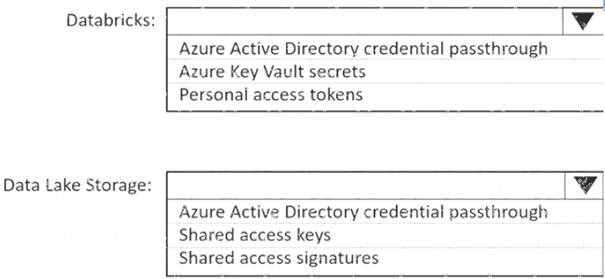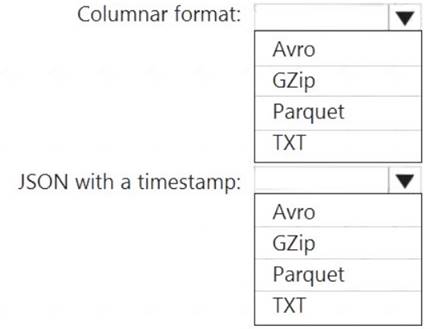- (Exam Topic 3)
You have an Azure subscription that contains an Azure Synapse Analytics dedicated SQL pool named SQLPool1.
SQLPool1 is currently paused.
You need to restore the current state of SQLPool1 to a new SQL pool. What should you do first?
Correct Answer:
B
Reference:
https://docs.microsoft.com/en-us/azure/synapse-analytics/sql-data-warehouse/sql-data-warehouse-restore-active
- (Exam Topic 3)
You use Azure Data Lake Storage Gen2 to store data that data scientists and data engineers will query by using Azure Databricks interactive notebooks. Users will have access only to the Data Lake Storage folders that relate to the projects on which they work.
You need to recommend which authentication methods to use for Databricks and Data Lake Storage to provide the users with the appropriate access. The solution must minimize administrative effort and development effort.
Which authentication method should you recommend for each Azure service? To answer, select the appropriate options in the answer area.
NOTE: Each correct selection is worth one point.
Solution:
Table Description automatically generated
Box 1: Personal access tokens
You can use storage shared access signatures (SAS) to access an Azure Data Lake Storage Gen2 storage account directly. With SAS, you can restrict access to a storage account using temporary tokens with fine-grained access control.
You can add multiple storage accounts and configure respective SAS token providers in the same Spark session.
Box 2: Azure Active Directory credential passthrough
You can authenticate automatically to Azure Data Lake Storage Gen1 (ADLS Gen1) and Azure Data Lake Storage Gen2 (ADLS Gen2) from Azure Databricks clusters using the same Azure Active Directory (Azure AD) identity that you use to log into Azure Databricks. When you enable your cluster for Azure Data Lake Storage credential passthrough, commands that you run on that cluster can read and write data in Azure Data Lake Storage without requiring you to configure service principal credentials for access to storage.
After configuring Azure Data Lake Storage credential passthrough and creating storage containers, you can access data directly in Azure Data Lake Storage Gen1 using an adl:// path and Azure Data Lake Storage Gen2 using an abfss:// path:
Reference:
https://docs.microsoft.com/en-us/azure/databricks/data/data-sources/azure/adls-gen2/azure-datalake-gen2-sas-ac https://docs.microsoft.com/en-us/azure/databricks/security/credential-passthrough/adls-passthrough
Does this meet the goal?
Correct Answer:
A
- (Exam Topic 3)
You are designing an anomaly detection solution for streaming data from an Azure IoT hub. The solution must meet the following requirements: Send the output to Azure Synapse.
Send the output to Azure Synapse. Identify spikes and dips in time series data.
Identify spikes and dips in time series data. Minimize development and configuration effort. Which should you include in the solution?
Minimize development and configuration effort. Which should you include in the solution?
Correct Answer:
B
You can identify anomalies by routing data via IoT Hub to a built-in ML model in Azure Stream Analytics. Reference:
https://docs.microsoft.com/en-us/learn/modules/data-anomaly-detection-using-azure-iot-hub/
- (Exam Topic 3)
You are designing an Azure Stream Analytics job to process incoming events from sensors in retail environments.
You need to process the events to produce a running average of shopper counts during the previous 15 minutes, calculated at five-minute intervals.
Which type of window should you use?
Correct Answer:
B
Tumbling windows are a series of fixed-sized, non-overlapping and contiguous time intervals. The following diagram illustrates a stream with a series of events and how they are mapped into 10-second tumbling windows.
Reference:
https://docs.microsoft.com/en-us/stream-analytics-query/tumbling-window-azure-stream-analytics
- (Exam Topic 3)
You need to output files from Azure Data Factory.
Which file format should you use for each type of output? To answer, select the appropriate options in the answer area.
NOTE: Each correct selection is worth one point.
Solution:
Box 1: Parquet
Parquet stores data in columns, while Avro stores data in a row-based format. By their very nature,
column-oriented data stores are optimized for read-heavy analytical workloads, while row-based databases are best for write-heavy transactional workloads.
Box 2: Avro
An Avro schema is created using JSON format. AVRO supports timestamps.
Note: Azure Data Factory supports the following file formats (not GZip or TXT). Avro format
Avro format  Binary format
Binary format Delimited text format
Delimited text format  Excel format
Excel format JSON format
JSON format  ORC format
ORC format  Parquet format
Parquet format  XML format
XML format
Reference:
https://www.datanami.com/2018/05/16/big-data-file-formats-demystified
Does this meet the goal?
Correct Answer:
A